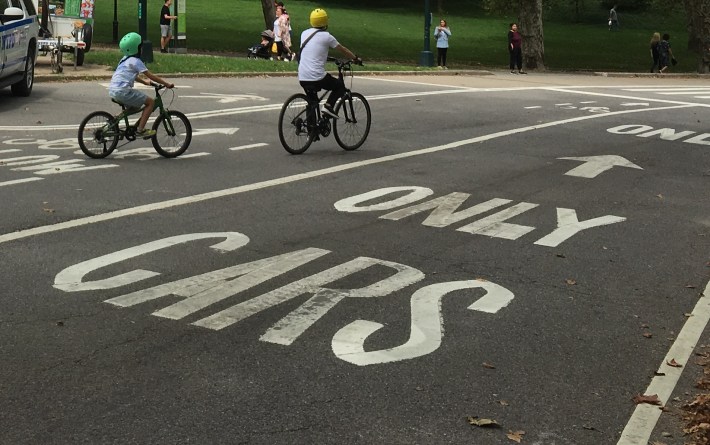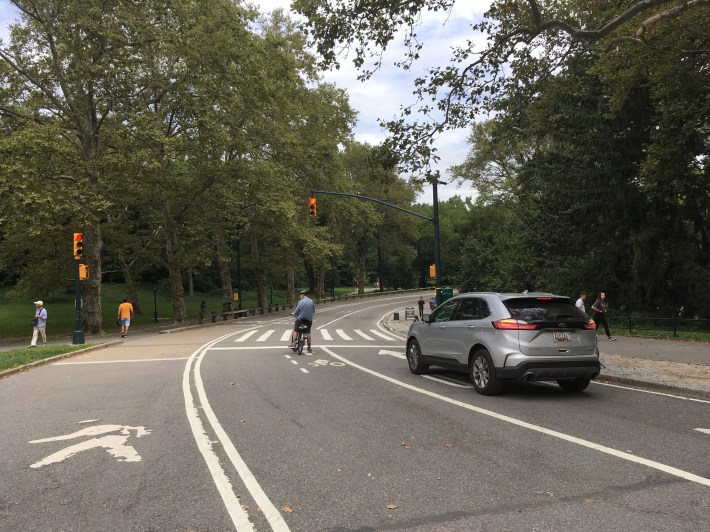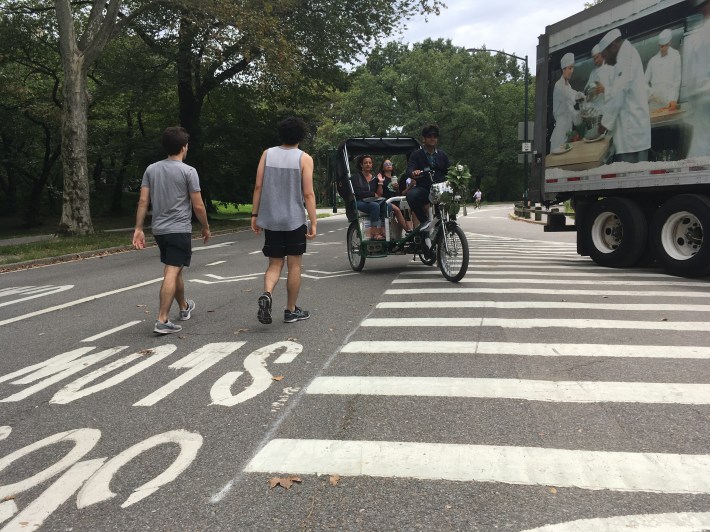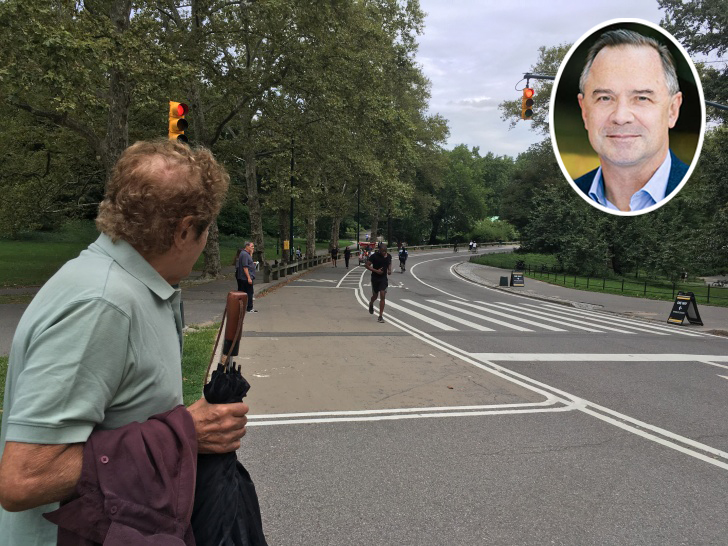Central Park has become so chaotic and dangerous that a former city parks commissioner says he won't bike in the greenspace anymore.
Adrian Benepe, who spent a decade as Mayor Bloomberg's parks commissioner, called the situation on the park's roadways a "crisis," telling Streetsblog that he had given up cycling in the park because of the "chaos," unpleasantness and danger caused by the park's growing popularity and a lack of pedestrian and cycling safety infrastructure.

"It's the Wild, Wild West. It has to stop being the Wild West," said Benepe, who now works at the Trust for Public Land.
The chaos starts with bad design — roadways are still striped for the (mostly absent) automobiles, and the many traffic signals inside the park don't immediately appear that they apply to pedestrians and cyclists. So it's not just that no one obeys the rules — it's not clear what those rules are. Indeed, Benepe said, after the park officially became car-free last June, the city "never figured out the new rules of the road."
If the city can't figure out the rules, how can the users? (Hint: They can't.)
The lawlessness of the park's roadways last week claimed the life of a cyclist, Charles Cheeseboro, 43, of Harlem. Last week, Cheeseboro struck a pedestrian and lost control of his e-bike on the east side of the park, landing on his head. He died two days later, the 20th cyclist to die in the city this year, double the number for all of 2018. The pedestrian suffered minor injuries.
Cheeseboro wiped out at an especially dangerous crossing, traffic-signalized intersection at about 74th Street on East Drive, just north of the 72nd Street Terrace Drive. The road there is a veritable textbook of bad street design — but so are many other spots in the park.

Traffic from the south and east converges, dumping into the intersection from a fairly steep incline. Traffic from the west approaches at two points. The traffic light and crosswalk sit in a trough, with the road angling upward just past it. Anyone coming off the hill on a bike from the south or east must defy momentum to stop. The crash remains under investigation, police said.
"It is a highly dangerous intersection for all users," said Ken Coughlin, former chairman of the Community Board 7 Parks and Environment Committee. "I've come close to being hit there myself while riding toward the East Side. Cyclists going north on the East Drive are rounding a small turn and picking up speed downhill. Cyclists and others heading east and trying to cross the drive have to really pay attention and move fast to avoid traffic to their right. And, to continue east on the 72nd Street crossing, they have to head slightly uphill and into the oncoming northbound traffic. Meanwhile, some northbound cyclists on the drive going down the hill are making a left onto the 72nd Street crossing, adding to the confusion."
The"wholly inadequate" pavement markings and signage there are "the main culprit" of the crash, Coughlin said.
Pedestrians aren't happy, either.
The intersection is "not safe," said Manhattanite Olga Baron as she pushed a client in a wheelchair on the Terrace Drive.

So what is going on?
Central Park remains in chaos, despite (or perhaps because of) the removal of cars last June. People are getting hurt all around the park — albeit in fewer numbers than when cars dominated the park, but there are more crashes.
In the previous 13 months before cars were banished, there were 39 reported crashes injuring 23 cyclists, one pedestrian, and one motorist. In the 13 months since, there were 41 reported crashes in the park, injuring 12 cyclists, four pedestrians, and three motorists (yes, motorists), according to city data.
(The idea that the park is "car free" is a gross exaggeration. The Department of Transportation said that the only permitted vehicles are emergency vehicles, workers using Parks or Conservancy vehicles, and trucks or cars servicing concessions like the Tavern on the Green. Yet many private cars inside the park belong to cops who work at the Central Park Precinct. Neither the NYPD nor DOT comments on that.)
The intersection where Cheeseboro suffered his fatal wounds is a perfect example of the chaos: pedicab drivers gesticulate wildly and crane their necks as they seek to cut west from the Terrace Drive across northbound East Drive traffic; cyclists ride the wrong way or make hairpin turns; horse carriages, joggers, and bikes form a scrum; recreational and racer cyclists ride at different speeds alongside tractor-trailers and joggers; scared pedestrians (some with pets) don't know what to do; distracted horse-cart drivers talk to their customers rather than keep their eyes on the road; scooter users and in-line skaters weave in and out; official and non-official cars use the loops like regular streets, and pretty much every kind of user ignores the traffic lights.

Of course, the Central Park roads have had safety problems from the get-go. The loops — built in the 19th century for strolling, horseback riding, and carriages — were altered repeatedly in order to accommodate automobiles; their present curves were drawn in the 20th century to slow down cars. In November, 1929, the city imposed one-way traffic rules on the east and west drives in order to stem vehicle carnage: Drivers crashed 338 times in the park in the first 10 months of 1929, killing eight people and injuring 249, the New York Times noted.
Cyclists also have killed two pedestrians in the park during the last five years. In one case, the cyclist swerved to avoid a group of pedestrians in the bike lane, hitting another. In the other, a 17-year-old cyclist hit a jogger.
What can be done?
Benepe outlined a plan for fixing the loops that might entail such "safety corridors" for pedestrians and the recreational cyclists and bike commuters who make of the majority of park bikers. He said the city needs to take a hard look that should include:
- a study by an outside mobility-engineering consultant to rethink the loops and institute 21st-century signaling (such as flashing yellow signals at night),
- an interagency task force to re-envision park mobility and pilot the new system,
- a two-thirds cut in the around 200 pedicabs, with their regulation as a park concession,
- speed limits and other rules to discourage the fast cyclists who use the loops for racing from riding during heavy-use hours, and
- clear regulations for all users, enforced by ticketing.
- and, most radically, a Parks Department takeover of the park roadways DOT, which would officially signal that this pavement is no longer a city "street." Such a turnover would make it easier to redesign the roadways as "shared streets."
The park, which hosts 200,000 people a day, is "a small city," Benepe said. "You should have the infrastructure to keep that city safe. It's not there now."
So @NYPDCentralPark's #baddbee has two Chargers. They both have a missing front license plate. Both have a rear plate that says "BADD BEE."
— placard corruption (@placardabuse) May 7, 2018
And the Integrity Control Officer hasn't noticed any problems? pic.twitter.com/9NUcyHd3jS
Managing such infrastructure is not an occult science. The Federal Highway Administration publishes guidelines for it. These say that the "design of off-road trails must be done with the same care and attention to recognized guidelines as design of bike lanes on roadways."
"Trails are often extremely popular facilities that are in high demand among rollerbladers, bicyclists, joggers, people walking dogs, and a variety of other users," the guidelines state. "The resulting mix and volume of non-motorized traffic can create dangerous conditions that should be anticipated during the design phase." (No kidding!)
Is anyone doing anything?
The crisis in Central Park may be dawning on city officials — sort of. But when Streetsblog contacted various agencies after Cheeseboro's death, all we got is boilerplate statements.
- Central Park Conservancy spokeswoman Mary Caraccioli said her organization "recognizes that traffic on park drives has become dangerous to riders and pedestrians and requires immediate intervention." She said the Conservancy is working with the Parks Department, DOT, NYPD and park-user groups "to create a plan to improve the safety and security of the drives ...which need to be regulated and managed to avoid tragedies like this week’s accident."
- Parks Department Assistant Commissioner Crystal Howard said: "We are saddened by this unfortunate death. We will review former Parks Commissioner Adrian Benepe’s recommendations, as we continue to work with all relevant agencies on the matter."
- DOT spokesman Scott Gastel said: "We take this tragedy very seriously and will discuss any recommendations with fellow agencies involved in the park’s operational and enforcement areas." The agency says it's updating the markings throughout the park as roads are repaved and meets regularly with Parks and the Conservancy to prioritize bikes and pedestrians.
- City Hall has left the building with its boss — and declined to comment. (It's a reminder of why Streetsblog called on the mayor to resign when he announced his run for president.)
- The DOT's "Vision Zero partners" in the NYPD did not respond at all.






